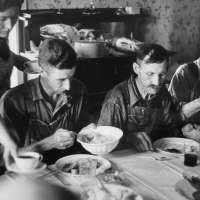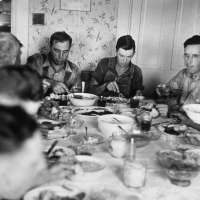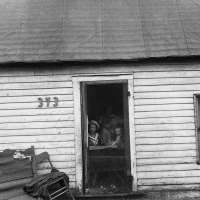

Ben Shahn
Boy in front of liquor store, Newark, Ohio, 1938
Paper: 8 x 10 inches
Ben Shahn
Ben Shahn Biography Ben Shahn (1898-1969) is renowned as one of the leading American artists of the Social Realist movement in the mid-twentieth century. Shahn originally began his career as a painter, lithographer, and muralist, but it was his foray into photography during the Great Depression that cemented his artistic legacy in American history. Shahn’s striking photographs from the 1930s confront viewers with an incisive commentary on poverty, injustice, and mass unemployment in rural farming communities across America. Aligning with his realist style, Ben Shahn’s Depression-era pictures showed life as it was, not as his subjects or viewers wished it to be. Ben Shahn was born in 1898 to a poor Jewish family in Kaunas, Lithuania (formerly Kovno, Russia). His father, a wood craftsman, was arrested under suspicion of revolutionary activities and exiled to Siberia in 1902. In Kovno, the Shahn family faced constant threats of violence and religious persecution; that same year, their neighborhood was burned to the ground by antisemites. Ben Shahn was six years old when his family immigrated to the United States, resettling in Brooklyn, New York. Before receiving recognition as a fine artist, Ben Shahn made his living as a typographer and lithographer, sharing a New York studio with photographer Walker Evans. In 1935, Evans recommended Shahn’s services to Roy Stryker, director of the photography group at the Resettlement Administration (RA), later renamed the Farm Security Administration (FSA). The FSA was a New Deal agency designed to address and document widespread poverty caused by the Great Depression, with a focus on rural agricultural communities. As an official FSA photographer, Ben Shahn joined the ranks of Evans, Gordon Parks, and Dorothea Lange, traveling the U.S. for five dollars a day plus five cents per mile. Even in this illustrious company, Shahn’s photographs rank among the Historical Section’s most accomplished. Ben Shahn was originally hired by Stryker as a propaganda lithographer, not a photographer, and the artist often insisted that his photographs were merely raw material for his paintings and posters. The emotive power of his photography proved otherwise, however, and in the summer of 1938, Shahn was sent on assignment to photograph small-town life in agricultural Ohio. Working in a limited geographical area provided Shahn with an exceptional scope to investigate the realities and causes of rural deprivation and impoverishment. Shahn used a Leica with a right-angle viewfinder, allowing him to photograph subjects to his right without their knowledge, creating spontaneous and authentic street portraits. No matter where Ben Shahn pointed his camera, he found telling details that went beneath the surface. The ensemble of his Ohio photographs speaks to the resilience of the human spirit in the face of adversity, portraying the struggle and dignity of ordinary Americans. As an immigrant who experienced hardship and discrimination himself, Ben Shahn empathized greatly with the subjects he photographed; in his own words, he “just took pictures that cried out to be taken.” Shahn’s artistic legacy extends far beyond the FSA and the Great Depression—his images are timeless, almost universal. From the 1930s onward, Ben Shahn’s photographs have been shown widely in major art museums in New York, London, Amsterdam, Brussels, Rome, and Vienna. Shahn was featured in Edward Steichen’s famous touring exhibition The Family of Man, and his FSA photographs have been the subject of several monographs, including The Photographs of Ben Shahn (2008), Ben Shahn’s American Scene (2010), and Ben Shahn: 400 FSA Photographs (2016).






